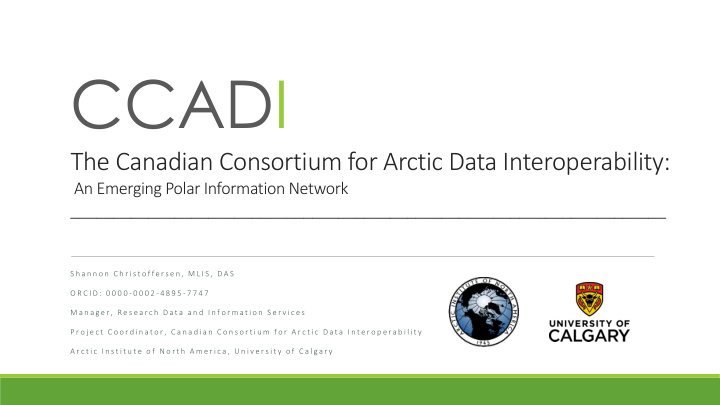



CCADI The Canadian Consortium for Arctic Data Interoperability: An Emerging Polar Information Network _____________________________________________________________________ S h a n n o n C h r i s t o f f e r s e n , M L I S , D A S O R C I D : 0 0 0 0 - 0 0 0 2 - 4 8 9 5 - 7 7 4 7 M a n a g e r , R e s e a r c h D a t a a n d I n f o r m a t i o n S e r v i c e s P r o j e c t C o o r d i n a t o r , C a n a d i a n C o n s o r t i u m f o r A r c t i c D a t a I n t e r o p e r a b i l i t y A r c t i c I n s t i t u t e o f N o r t h A m e r i c a , U n i v e r s i t y o f C a l g a r y
Arctic Institute of North America, Geomatics and GeoSensorWeb Lab, Cartographic and InnoVis Lab Current SensorUp Inc. Research UCalgary Centre, CarletonU Centre for Membership Earth Polar View Observation Science, UManitoba Polar Data Canadian Catalogue and Canadian Cybera Inc. Cryospheric Consortium for Information Network, Arctic Data UWaterloo Interoperability Centre Natural d'études Resources Nordiques and Canada Amundsen (NRCan) Science, ULaval Polar Faculty of Law, Knowledge UOttawa Canada Inuvialuit Inuit Tapiriit Regional Kanatami Corporation
CCADI and ARDI (Arctic Research Data Infrastructure) Governance ARDI Project Management and CCADI/ARDI Long-term Governance Model Diagram Courtesy of Maribeth Murray.
CCADI Objectives Establish an integrated Canadian Arctic data management system that will: Facilitate transformative research on priority science questions about the Arctic system; Empower Inuit communities to address their data priorities; Demonstrate Canada’s ability to lead in providing accessible, interoperable, and useable data to the international community; and Enable translation of complex scientific information and Inuit TK into policy-relevant material.
“The ability of computer systems or software to Interoperability exchange and make use of information” - OED Technical Semantic Human
Proposed CCADI Architecture and Deployment Diagram courtesy of David Arthurs and Peter Pulsifer.
Ethically Open Data Data are made available fully, freely, and openly with minimal delay. The only exceptions to this requirement of full, free, and open access are: where human subjects are involved, confidentiality shall be protected as appropriate and guided by the principles of informed consent; where local and traditional knowledge is concerned, rights of the knowledge holders shall not be compromised; where data release may cause harm, specific aspects of the data may need to be kept protected (for example, locations of nests of endangered birds or locations of sacred sites). - IASC Statement of Principles and Practices for Arctic Data Management, April 16, 2013 http://www.iasc.info/images/pdf/IASC_data_statement.pdf
Inuit Knowledge Objectives Achieve better understanding of opportunities for and barriers to ICT use by Inuit and others; Achieve better understanding of how existing Arctic data infrastructure is used, and how co- design can transform it to support Inuit, academic, and other needs; Establish a pathway to resolving inequities in information access by identifying best practices for ICT development that meet Inuit needs and facilitate use; Develop an ethical framework for information sharing that respects Inuit rights, protects sensitive data, and advances integration of social/natural science data with Inuit Knowledge (IK).
CCADI.ca
Thank You! Shannon Christoffersen shannonv@ucalgary.ca
Recommend
More recommend